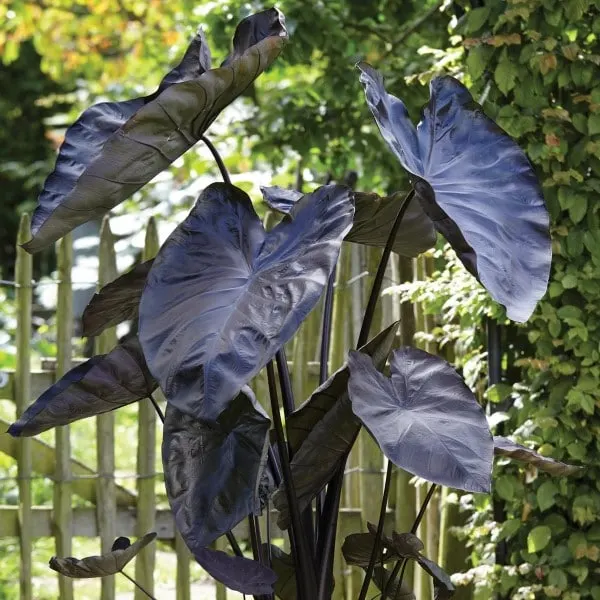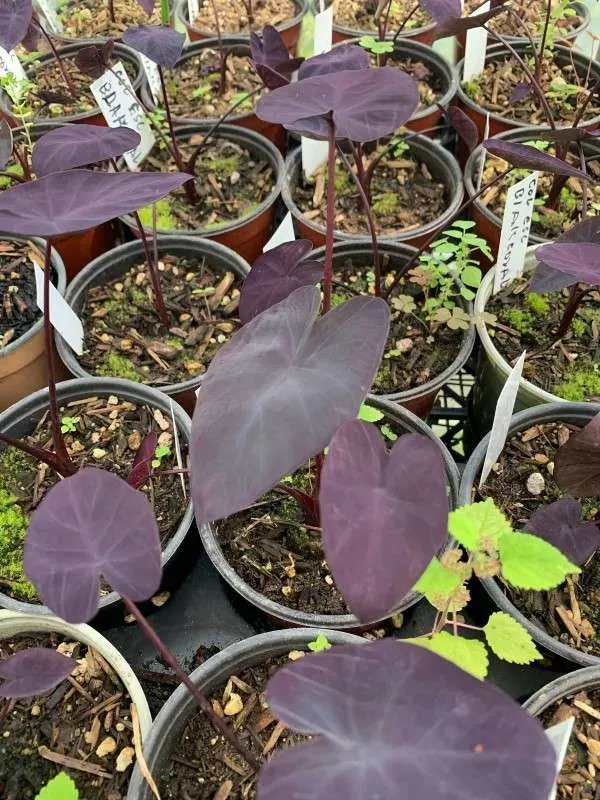Colocasia Black Coral originated from the areas of tropical Eastern Asia. The plant was introduced as a food crop in America for enslaved people. It is a part of the Araceae family of plants.
It’s a fascinating deep black plant that can be grown near areas with excess water. The dark color of the plant makes the plant prominent in the surrounding light-colored plants.
The Colocasia Black Coral is also known as the elephant ear because of the enormous leaves resembling elephant ears.

The main characteristics of the Colocasia Black Coral
Growth & Size
As compared to other plants, Colocasia Black Coral is quite tall. When provided with adequate care, the plant has shown a maximum height of 3.5 to 4.5 feet and a width of 2.5 to 3.5 feet. In addition, it is observed that in the spring season, their leaves grow rapidly.
Leaves
The Colocasia Black Coral has unique leaves. The plant has quite broad leaves which can grow up to 1.75 feet. They are the shape of a heart and have pretty prominent veins. The leaves are black; however, the blade and petiole are purple.
The plant’s foliage is also very thick, shiny, and has a smooth surface compared to other plants.
There is a probability that the plant’s thick leaves can get damaged by holding up water on the leaves. The best way to protect the leave is to provide sufficient air circulation, which dries up the moisture on the surface of the leaves.
Flower
The plant’s flowers are grown in clusters and are yellow. The flowers do not often show, and even if they do, they are hidden under the plant’s foliage.
Diseases
The Colocasia Black Coral doesn’t get attacked by infections and diseases. However, you have to be careful as it can be attacked by aphids, damaging the plant’s leaves.
Fruits
The Colocasia Black do not usually grow a fruit. They sometimes produce a tiny berry.

Taking care of Colocasia Black Coral
Water
The Colocasia Black Coral is quite fond of water. Therefore, the perfect technique to water your plant is to give the water every week, especially in the summer season. The amount of water should be sufficient to keep the soil moist until the next shift.
It can quickly take up the water through the roots when grown near a pond, river, or stream.
If the plant is not given the right amount of water, it can suffer drought. Therefore, it is also recommended that drainage holes are created in the pot to remove excess water retained at the bottom of the plant.
Soil
The plant needs moist soil to grow healthy. If the soil dries out, there is a chance that the plant will die.
For potting the plant indoors, it needs good drainage. It cannot survive in soggy soil; hence holes can be made to facilitate drainage. In addition, the soil should have air circulation and be nutritious for growing a healthy Colocasia Black Coral plant.
Lighting
Colocasia Black Coral cannot grow through indirect exposure to sunlight. The ideal sunlight to meet the requirement of your plant would be bright but indirect sunlight. To be kept as a houseplant, it must be held in a place where it receives partial shade.
The plant shows its best colors when kept in the sun; however, keeping it in direct sunlight can scorch the leaves and make the plant lose its black color.
Temperature
Colocasia Black Coral can survive well in warm temperatures if it is not kept in direct sunlight. However, very high temperatures can increase the chances of infectious attacks and diseases.
Humidity
Humidity is significant for the growth of any plant, especially for plants that are grown in tropical areas. Therefore, we can say that Colocasia Black Coral needs high humidity.
In drier regions, it is suggested that you keep a humidifier to give the plant suitable humidity for developing healthy growth.
Fertilizers
This Colocasia Black Coral loves to take nutrients; therefore, the soil should provide the plant with sufficient nutrition to grow properly.
However, fertilizers should be given in a moderate amount as too much of them can damage the plant.
Pruning
Colocasia Black Coral can be trimmed from time to time for maintenance. However, the spring season is the best season for pruning the plant, as, during that time, the plant displays its maximum growth.
Pruning removes the dead or damaged leaves and helps the plant grow healthy.
Propagation of the Colocasia Black Coral
There are two ways through which you can do the propagation of your Colocasia Black Coral in-house. They are:
- Propagation by water.
- Propagation by division.
Water Propagation
Steps:
- Remove a cutting from the Colocasia Black Coral mother plant.
- Be careful, as only a few leaves should be present on the upper side of the plant.
- Then place the stem cutting in the container with clean water.
- It will help if the water is changed regularly to protect the plant from any infectious attack.
- Place the container in an area away from direct sunlight for good growth.
- Now observe the development of the plant regularly.
- Once the plant grows a certain height, it can be replanted into the soil.
Propagation by Division
Steps:
- Another method to propagate your Colocasia Black Coral is by root division.
- Start digging the plant out of the soil.
- Then remove the unnecessary found in the roots.
- Cut the roots carefully with sharp equipment.
- After cutting the roots, fill your pots with new soil.
- Transfer each divided plant into a new pot.
- Water your plant regularly to see the results.
Summary
The Colocasia Coral Black is a very rare black plant which is ideal for growing indoors. When provided with proper environmental conditions, the plant can grow quite quickly.
The propagation of a Colocasia Black Coral is pretty simple. They can be propagated by using two methods which are discussed above.
